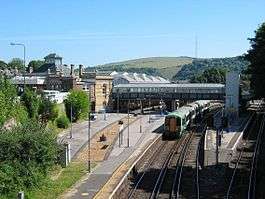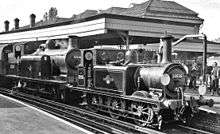Lewes railway station
| Lewes | |
|---|---|
 | |
| Location | |
| Place | Lewes |
| Local authority | Lewes |
| Grid reference | TQ416098 |
| Operations | |
| Station code | LWS |
| Managed by | Southern |
| Number of platforms | 5 |
| DfT category | C2 |
|
Live arrivals/departures, station information and onward connections from National Rail Enquiries | |
| Annual rail passenger usage* | |
| 2004/05 | 2.406 million |
| 2005/06 |
|
| 2006/07 |
|
| 2007/08 |
|
| 2008/09 |
|
| 2009/10 |
|
| 2010/11 |
|
| 2011/12 |
|
| 2012/13 |
|
| 2013/14 |
|
| 2014/15 |
|
| History | |
| 1846 | Opened |
| 1857 | Resited |
| 1889 | Rebuilt |
| National Rail – UK railway stations | |
| * Annual estimated passenger usage based on sales of tickets in stated financial year(s) which end or originate at Lewes from Office of Rail and Road statistics. Methodology may vary year on year. | |
|
| |
Lewes railway station serves the town of Lewes in East Sussex, England. It has five platforms and is on the East Coastway Line. Train services are provided by Southern.
The station has a café and there is a taxi office on the main forecourt. There is a small taxi rank outside.
Layout
The station platforms are arranged in a "V" shape, with a large courtyard in between, which is bound by the tracks (platforms 2 & 3) on two sides and the station building on the third side. The two-floor building, with the entrance from the top floor, is accompanied with a gallery, which extends to the other platforms (1, 4 & 5) as the passenger bridge.
There have been many changes during the lifetime of the station (see history section, below).
The typical arrangement for services is:
Northern platforms
Platform 1 is an eastbound platform for trains towards Eastbourne, Seaford and Hastings, from London
Platform 2 is a westbound platform for trains towards London Victoria via Haywards Heath
Southern platforms
Platform 3 is an eastbound platform for trains towards Eastbourne, Seaford and Ashford, from Brighton
Platform 4 is a westbound platform for trains to Brighton from Eastbourne and Ashford
Platform 5 is a bi-directional through platform for terminating trains towards Brighton and Seaford
Services
The typical off-peak service is:
- 5tph to Brighton
- 2tph to London Victoria via Gatwick Airport
- 2tph to Ore via Eastbourne and Hastings
- 1tph to Ashford International via Eastbourne and Hastings
- 2tph to Seaford
- 1tph to Eastbourne
(tph = trains per hour)
| Preceding station | |
Following station | ||
|---|---|---|---|---|
| Falmer | Southern East Coastway Line (Seaford Branch Line) |
Southease or Newhaven Town | ||
| Wivelsfield or Plumpton or Cooksbridge |
Southern East Coastway Line (Victoria-Eastbourne or Ore) |
Polegate | ||
| Falmer | Southern East Coastway Stopping |
Glynde | ||
| Brighton | Southern East Coastway Fast |
Polegate (Glynde on Sundays) | ||
| Disused railways | ||||
| Barcombe Line and station closed |
London, Brighton and South Coast Railway Lewes and East Grinstead Railway |
Terminus | ||
| Barcombe Mills Line and station closed |
London, Brighton and South Coast Railway Wealden Line |
Terminus | ||
History

The first station in Friars Walk opened in 1846 was originally built as a terminus on the Brighton line. This station became inconvenient after extra tracks were laid to Hastings, meeting the Brighton line at a junction just west of Lewes Station (i.e. towards Brighton), necessitating reversals for trains serving Lewes. Capacity increases also became desirable because of new direct links to London. This first station was therefore replaced; the original booking hall with grand classical columns outside survived until the 1960s but was then demolished. A second station was opened in 1857 and closed in 1889. The present station opened in 1889 in connection with a new track alignment to ease the curve east of the station. The old alignment became goods lines serving the goods depot until circa 1968.
Not all of the lines serving Lewes Station survived the 20th century. The Wealden Line had headed north to Uckfield and on to London via Eridge — this line also had trains to Tunbridge Wells West. This line has been closed and lifted between Lewes and Uckfield. Branching off the Lewes to Uckfield section at Culver Junction was the southern portion of the Bluebell Railway, a section of which remains as a preserved railway.
Timeline
- 8 June 1846
- Line from Brighton opened
- A terminus was provided in Friars Walk for services arriving from Brighton (1846–57).
- 27 June 1846
- Line is extended from Lewes to Hastings
- A platform is provided, called "Ham (or Southover)", slightly west of the divergence for the Hastings line (1846–48).
- 2 October 1847
- Keymer Junction to Lewes line opened
- Platforms (going by the name of Pinwell) are built opposite the Terminus, west of the Hasting line divergence, serving trains to and from the Hasting direction (1847–57).
- 1857
- A new station is built at the divergence of the Keymer line
- This was the first station at this site, the station building being of a Swiss chalet style [1] (1857–89).
- 1 October 1886
- a new junction for the realigned Wealden Line opened
- The alignment of this line appears to have passed through the location of the original terminus; the station goods yard also being at this location. Until this date the Wealden line joined the Keymer line at a junction between the north portal of Lewes Tunnel and Cooksbridge Station [2] (see the Wealden Line article for details).
- 17 June 1889
- Current station opened.
- The 1857 station is totally rebuilt and the track layout changed; this new station is the one still in use today.
- On 5 November 1960, Lewes suffered severe flooding, legend has it that the Borough Surveyor requested that the London Platforms be blown up to allow flood water to escape via the railway track-bed. The British Railways district Engineer declined to co-operate.[3] In the 1960s, the original 1846 terminus building fronting the public street (Friars Walk), was demolished.[4][5][6]
Accidents and incidents
- On 3 November 1960, severe flooding affected the station, with over a foot (30cm) of water covering the lines. All electric services were suspended. Services were worked by steam locomotives and the Hastings Units until 6 November. The line to Wivelsfield was inoperable for some time.[7]
References
- ↑ page 22, London, Brighton & South Coast Railway Album; Klaus Marx, Ian Allan, 1982, ISBN 0-7110-1187-7
- ↑ Undated map from The Railway Magazine, reproduced in Brighton to Eastbourne by Vic Mitchell & Keith Smith, Middleton Press, 1985, ISBN 0-906520-16-9
- ↑ plate 65, Brighton to Eastbourne by Vic Mitchell & Keith Smith, Middleton Press, 1985, ISBN 0-906520-16-9
- ↑ plate 48, Brighton to Eastbourne by Vic Mitchell & Keith Smith, Middleton Press, 1985, ISBN 0-906520-16-9
- ↑ maps opposite plate 50, Brighton to Eastbourne by Vic Mitchell & Keith Smith, Middleton Press, 1985, ISBN 0-906520-16-9
- ↑ London, Brighton & South Coast Railway Album, Klaus Marx, Ian Allan, 1982, ISBN 0-7110-1187-7
- ↑ Glover, John (2001). Southern Electric. Hersham: Ian Allan. pp. 142–43. ISBN 0 7110 2807 9.
External links
- Train times and station information for Lewes railway station from National Rail
- Wealden Line Campaign
Coordinates: 50°52′15″N 0°0′42″E / 50.87083°N 0.01167°E